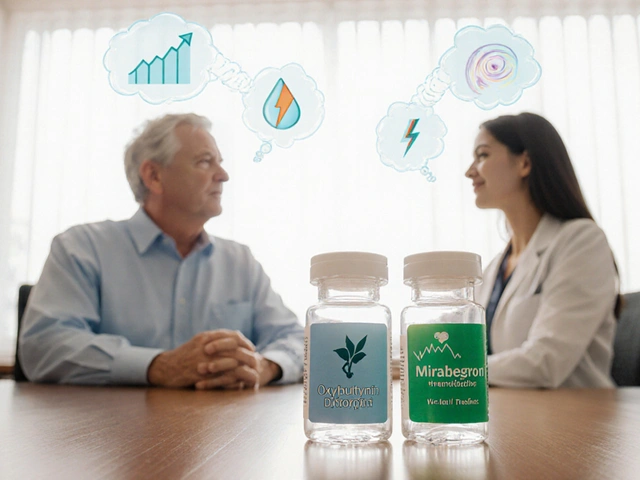Valproic Acid and Pregnancy: What You Need to Know

Understanding Valproic Acid and Its Uses
As an expectant mother, it's essential to be aware of the medications that can affect your pregnancy. One such medication is valproic acid, a widely prescribed drug used to treat various conditions. Valproic acid is often prescribed to treat epilepsy, bipolar disorder, and migraine headaches. It works by helping to restore the balance of certain chemicals in the brain, which helps to reduce the severity and frequency of seizures and mood swings.
However, when it comes to pregnancy, the use of valproic acid can be a cause for concern. This is because there have been numerous studies linking the use of this medication during pregnancy with an increased risk of birth defects and developmental issues. In this article, we will delve into the various aspects of valproic acid and pregnancy to help you make an informed decision about your treatment options.
Valproic Acid and Birth Defects: The Risks Involved
Research has shown that the use of valproic acid during pregnancy increases the risk of birth defects in the baby. Some of the most common birth defects associated with valproic acid exposure include neural tube defects (such as spina bifida), heart defects, and facial abnormalities (such as cleft lip and palate).
The risk of these birth defects is higher during the first trimester of pregnancy, which is a critical period for the development of the baby's organs and structures. It is important to note that the absolute risk of birth defects associated with valproic acid is still relatively low, but it is significantly higher compared to the general population or those taking other anti-seizure medications. As such, it is essential to discuss the risks and benefits of using valproic acid during pregnancy with your healthcare provider.
Developmental Delays and Learning Disabilities in Children
Aside from the increased risk of birth defects, the use of valproic acid during pregnancy has also been linked to developmental delays and learning disabilities in children. Studies have shown that children exposed to valproic acid in utero have a higher risk of cognitive and behavioral problems, including lower IQ scores, poor language skills, and difficulties with attention and memory.
These developmental issues can have long-lasting effects on a child's ability to learn and socialize, and they may require additional support and interventions throughout their lives. It is important to weigh the potential risks of valproic acid use during pregnancy against the benefits of seizure control, as uncontrolled seizures can also pose significant risks to both the mother and the baby.
Alternatives to Valproic Acid During Pregnancy
If you are pregnant or planning to become pregnant and are currently taking valproic acid, it is essential to discuss your options with your healthcare provider. There may be alternative medications that can effectively manage your condition with a lower risk of potential complications during pregnancy.
For instance, other anti-seizure medications, such as lamotrigine and levetiracetam, have been shown to have a lower risk of birth defects and developmental issues compared to valproic acid. However, it is crucial to work closely with your healthcare provider to determine the best course of action for your specific situation, as every individual's needs and circumstances are unique.
Planning for a Safe Pregnancy While on Valproic Acid
If you and your healthcare provider determine that continuing valproic acid during pregnancy is the best option for you, there are steps you can take to help minimize the potential risks to your baby. First and foremost, it is crucial to maintain close monitoring and communication with your healthcare team throughout your pregnancy to ensure that your condition is effectively managed and any potential issues are addressed promptly.
Additionally, taking a higher dose of folic acid before and during pregnancy may help reduce the risk of neural tube defects associated with valproic acid exposure. Your healthcare provider may recommend a daily dose of 4 to 5 milligrams of folic acid, which is higher than the standard recommendation for pregnant women. It is essential to follow your healthcare provider's guidance on folic acid supplementation and any other prenatal care recommendations to support a healthy pregnancy.








Ah, the ever‑so‑optimistic promise of valproic acid: a miracle drug that somehow manages to both stabilize seizures and, apparently, destabilize embryonic development-a truly unparalleled feat of pharmacology. One cannot help but marvel at the sheer audacity of prescribing such a compound to expectant mothers, as if the universe itself conspired to test our collective moral fiber. Yet, fear not, for the article so graciously outlines the benefits alongside the risks, presenting a balanced view that would make even the most seasoned ethicist blush with admiration. Surely, the solution lies in a careful titration and a daily regimen of high‑dose folic acid, because why not gamble with a baby’s neural tubes while clutching a supplement bottle? Moreover, the piece wisely suggests alternatives like lamotrigine, hinting at a world where we might one day abandon the notion of dangerous drugs altogether. In a perfect world, physicians would simply swap out valproic acid with a safe, non‑teratogenic alternative, sparing families the dreaded decisions. Until that utopia arrives, we must commend the article for giving us the tools to navigate this labyrinthine dilemma. And, as always, may your seizures be few and your coffee be strong.
While the content is undeniably useful, I couldn't help noticing a few grammatical slips that might benefit from a quick edit. For instance, the phrase "the use of valproic acid during pregnancy can be a cause for concern" could be tightened to "can cause concern" for conciseness. Additionally, the sentence "Studies have shown that children exposed to valproic acid in utero have a higher risk of cognitive and behavioral problems" would read smoother as "Studies show that in‑utero exposure to valproic acid increases the risk of cognitive and behavioral problems." Lastly, the list of birth defects could use a serial comma for clarity: "neural tube defects, such as spina bifida, heart defects, and facial abnormalities." Minor tweaks, but they enhance readability without altering the meaning.
Enough of the polite medical jargon-let's face the cold, hard truth: Big Pharma has been pumping valproic acid into the market for decades while hiding its teratogenic horrors behind glossy brochures. The so‑called "studies" are often funded by the very companies that profit from the drug, making any claim of safety suspect at best. It's no coincidence that the FDA's warning labels are buried deep in the fine print, ensuring that most patients never see the real danger. Moreover, the push to replace valproic acid with newer, supposedly safer alternatives is merely a PR stunt to keep the profit streams flowing, not a genuine concern for maternal health. If you value your unborn child's future, you must look beyond the official recommendations and question who truly benefits from this pharmaceutical agenda.
OMG, this article is a rollercoaster! 😱 One minute you're learning about how valproic acid can help with seizures, the next you're terrified of neural tube defects! 😨💔 It's like watching a drama series where the hero turns into a villain mid‑season. And those alternatives? Lamotrigine sounds like a fancy spa treatment compared to the drama of valproic acid! 🙌✨ Stay safe, folks, and keep those folic acid supplements handy-might as well armor up for the plot twists! 💊💪
From an ethical standpoint, prescribing a teratogenic medication to a pregnant individual without exhaustive counseling borders on negligent malpractice. The duty of care demands transparent disclosure of all known risks, especially when the potential for irreversible birth defects exists. It is morally indefensible to prioritize seizure control over the sanctity of nascent human life without offering viable, less hazardous alternatives. Therefore, clinicians must embody the highest standards of probity, ensuring that each treatment decision is underpinned by informed consent and an unwavering commitment to do no harm.
One must admire the cultural dexterity required to navigate both Western pharmacology and the nuanced expectations of diverse patient populations when discussing valproic acid. It is, of course, quintessentially ironic that a medication hailed for its neurological benefits could simultaneously jeopardize embryonic development-a paradox reminiscent of cultural appropriation debates, where benefits are harvested while costs are borne by others. Nonetheless, the article adeptly bridges this gap, offering a balanced perspective that honors both scientific rigor and cultural sensitivity. One could almost applaud the deftness with which the narrative sidesteps ethnocentric bias, all while maintaining a wry, sarcastic undertone that tickles the intellect.
America doesn't let pharma poison its kids!
Allow me to point out a couple of nitpicks: the article uses "birth defects" twice in the same paragraph without a hyphen-"birth‑defects" would be more precise. Also, "higher risk of birth defects" should read "higher risk of birth defects" (no need for the extra "the"). Finally, watch the case of "Valproic Acid"; consistent capitalization improves readability. 🧐
Honestly, the whole valproic acid saga feels like an over‑hyped Broadway show-lots of drama, some flashy numbers, but ultimately a thin plot. The article tries hard to sound scholarly, yet it merely scratches the surface of a complex pharmacological debate. It's as if the author tossed in a few citations to appear credible while neglecting the deeper mechanistic insights. In short, a mildly entertaining read, but not exactly Pulitzer‑worthy.
Sure, valproic acid might have risks, but we've all heard the hype about alternatives-sometimes the grass is just as brown. I’d argue that focusing solely on medication overlooks lifestyle factors that can be equally influential. So, perhaps we should broaden the conversation rather than get tunnel‑visioned on pills.
Reading through the piece, I appreciate the balanced tone-good to see both the therapeutic benefits and the potential teratogenic concerns laid out without sensationalism. It's a solid reference for anyone navigating this tricky medical decision.
First off, I want to acknowledge how overwhelming this topic can feel for anyone considering pregnancy while on valproic acid; it's perfectly normal to feel a mix of fear and confusion. The article does a commendable job of breaking down the medical jargon into digestible pieces, which is exactly what we need right now. That said, it's crucial to remember that each person's situation is unique, and no single article can replace personalized medical advice. You should definitely have an open conversation with your neurologist and obstetrician, outlining your treatment goals and concerns. If your doctor suggests switching to lamotrigine or levetiracetam, ask about the timeline for tapering off valproic acid to avoid seizure breakthrough. In addition, requesting a referral to a genetic counselor can provide valuable insight into any residual risks for your baby. Don't underestimate the power of a high‑dose folic acid regimen; studies suggest it can lower the chance of neural tube defects, so discuss the appropriate dosage with your provider. Remember, mental health is just as important as physical health-consider therapy or support groups to help manage anxiety during this transition. It's also helpful to keep a journal of any side effects or mood changes as you navigate medication adjustments. If you find yourself feeling isolated, reaching out to online communities of other mothers with similar diagnoses can be a source of comfort and practical tips. Finally, celebrate the small victories-whether it's a stable seizure count or a successful prenatal appointment. Your strength and resilience are evident, and with a collaborative care team, you can make the best-informed decisions for both you and your baby. Keep advocating for yourself, stay informed, and trust that you have the capacity to handle this complex journey.
Stay positive and proactive-consult your healthcare team early, explore alternative medications, and keep that folic acid daily. Your dedication to both your health and your baby's future will guide you toward the safest path.
It is incumbent upon us to recognize that the moral calculus of prescribing valproic acid during pregnancy is fraught with ethical peril. Choosing seizure control over fetal safety without exhaustive patient education borders on moral negligence. 🙅♂️ The compassionate course of action is to prioritize non‑teratogenic alternatives whenever feasible. 📚 In doing so, we uphold the sanctity of both maternal and neonatal wellbeing.
From an epistemic standpoint, the discourse surrounding valproic acid mirrors a classic case of iatrogenic externalities superseding therapeutic efficacy, thereby necessitating a paradigm shift toward pharmacovigilance‑centric frameworks. The prevailing reliance on monotherapy without robust risk stratification is antithetical to the principles of precision medicine. Ergo, stakeholders must converge on a multidisciplinary tableau that integrates teratogenic risk matrices with neuropharmacological optimization.